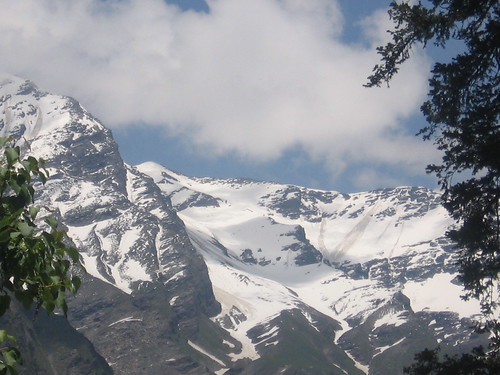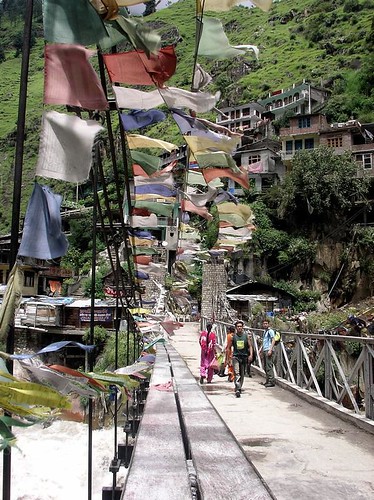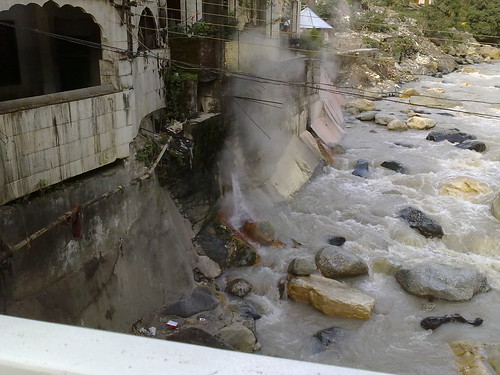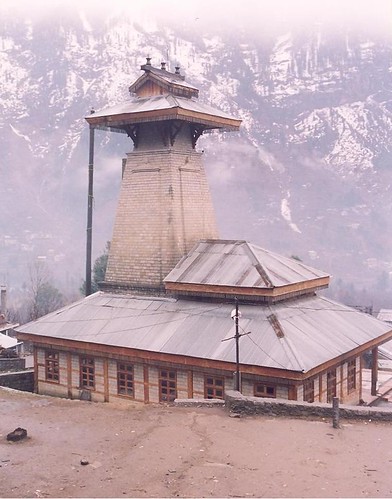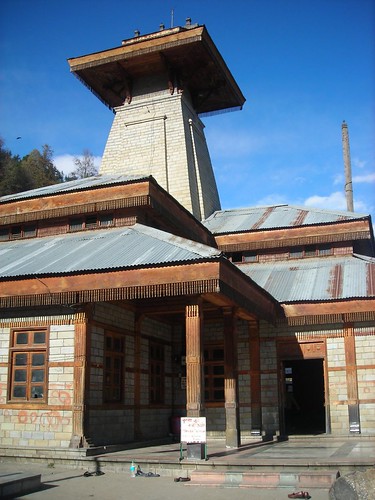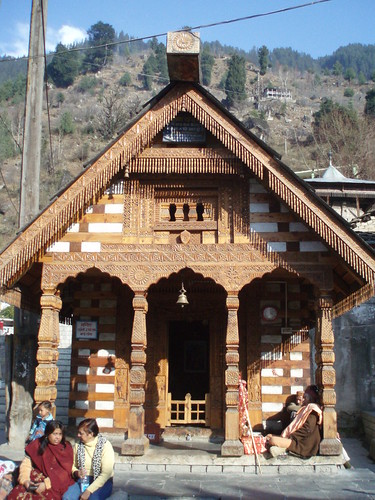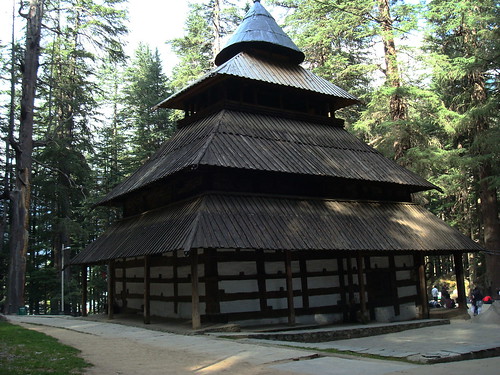
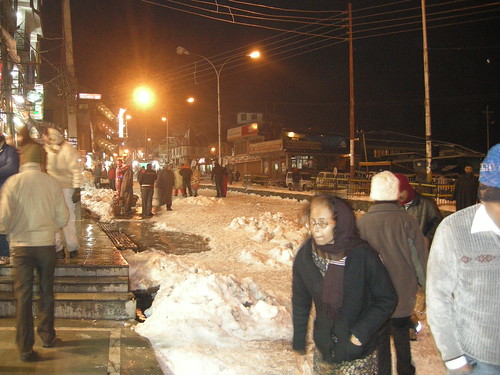
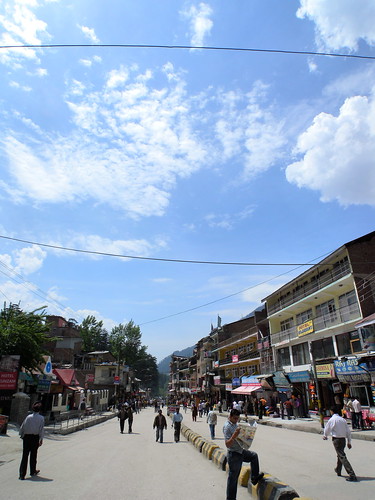
Manali, at the northern end of the Kullu Valley in Himachal Pradesh, is a hill station situated at a height of 2050 m (6398 ft) in the Himalayas. Situated on the Beas river (Vyaas in Hindi) and near its source, it is a popular tourist spot for Indians in summer and a magical, snow-covered place in winter. A staging point for a number of treks (Beas Kund, Chandrakhani Pass) and sports such as white-water rafting, Manali is also on the road to Ladakh via the valley of Lahaul and Spiti and rohtang pass which is main attraction near manali.
Manali is a popular Himalayan tourist destination and accounts for nearly a quarter of all tourist arrivals in Himachal Pradesh.[citation needed]Manali's cool atmosphere provides a contrast to hot Indian summers.
Manali is famous for adventure sports like skiing, hiking, mountaineering, paragliding, rafting, trekking, kayaking, and mountain biking. Yak skiing is a sport unique to this area.[4] Manali also featured in Time magazine's "Best of Asia" for its "Extreme Yak Sports".[4] Manali also offers hot springs, religious shrines and Tibetan Buddhist temples.
Manali has become a favorite destination for honeymooners since the last few years. Statistics show that around 550 couples reach Manali daily for honeymoon in season (May, June, December, January) and around 350 couples reaches Manali daily in rest time[citation needed].
Manali is known for its shiny gompas or Buddhist monasteries. With the highest concentration of Tibetan refugees in the entire Kullu valley, it is famous for its Gadhan Thekchhokling Gompa, built in 1969. The monastery is maintained by donations from the local community and through the sale of hand-woven carpets in the temple workshop. The smaller and more modern Nyingmapa Buddhist Gompa stands nearer the bazaar, in a garden blooming with sunflowers.
The locals drink two kinds of alcoholic beverages: Lugdi (plains) or Chang (Himalayan), a kind of crude beer made from fermented rice or barley and Sharab (plains) or Arak (Himalayan), an alcoholic drink distilled from Lugdi/chang. Arak can also be made from jaggery or apples or any other fruit.
It might be an interesting experience to visit a local home when the ladies make arak (quite regularly). You can sit in the fields where the ladies make it, have hot water from the distilling to wash with and "test" the product at frequent intervals.
Because there are apple orchards all around Manali, it's often possible to find apple cider. Besides this, there is alcohol available in bars, larger restaurants and the larger hotels
Kullu-Manali Valley is known as fruit bowl of India. Himcoop Juice Bar at The Mall Manali is one of the well know corner shop since 1972 selling 100% Natural Apple Juice and fruit drinks made from local fruits besides some syrups known as Fruit Crush to carry home to prepare fruit drinks after deluting with fresh water. Himcoop Juice Bar is located on the Main Mall as one of the corner shop next to Temple.
Eat
There are various restaurant and eating joints, which cater to the tourists having a wide range in budget and taste. The restaurants serve a variety of Indian and international cuisine, serving vegetarian and non - vegetarian delicacies. A tourist further has a choice of having the vegetarian fast food. There are bakeries and ice cream parlors in Manali which are known to satisfy the sweet toothed. One can try the manali food on Saturdays at the Club House in Old Manali.
Local Foods
Fruits and vegetables are included in the food of Manali. During celebrations and festivities, Vada, Bhatora and Patrodu are served at the eating joints. Milk and milk-based recipes are mainly included in the food habit of Manali people. Home made wine Chakti and Lugri, which is made of barley and red rice are a preferred Drink amongst locals and tourists. The traditional Manali food includes rice, curry or cooked beaten curd, a curd based dish, pulses, raita made of dry fruits, and sweet rice. The food is traditionally served on pattal (leaf plates).
If you are sick of dal/subzi/rice, an advantage of Manali's haphazard development is that there is a large choice of food from the numerous restaurants, many owned and run by Tibetans or Nepalis who learned their skills in Goa, Pokhara or Dharamsala.
Due to the many Israeli travellers, there are plenty of places selling mediterranean food alongside Tibetan specialties, Italian dishes of varying interpretation, the ubiquitous "continental".
Ironically, Indian food is now something of a rarity in Old Manali, and there is certainly no restaurant selling exclusively Indian food.
The meat in Manali market, mostly chicken or Mutton, tends to be good as local people are big meat eaters and the animals are less scrawny and better kept than in much of India. Most restaurants have a good turnover and buy meat daily in the season.
Old Manali is chock full of restaurants of wildly varying quality, but here is a pick of our favourites :
At the top of the road to the village, just past the Manu temple turning is the Manu Cafe, probably Old Manali's oldest cafe. They have a nice patio as well as a small indoor area and sell good basic food at cheap prices.
Further down, Little Tibet is on the steep part of the hill up to Old Manali does fine pasta and italian dishes including an excellent Carbonara, although they are little pricey. The Tibetan delicacies can be tried at Little Tibet.
Next door is the Shiva Garden cafe, which sells good - and cheaper - food, and has the advantage of an excellent view from the balcony of the traditional wood and stone building.
Down the hill 20 metres or so is Yangkhor who sell good quality specialty Tibetan food such as momo and thupka. Breakfast is good too, but most of their "continental" leaves something to be desired.
Opposite is Cafe Manalsu, a spacious and very atmospheric place with stripped pine tables and a view onto the Manalsu river. Its run by Rajiv, who makes the place worth visiting as much as the food, and plans to have a full scale pizza oven for 2004.
At the bottom of the hill next to the barbers is a small wooden chai shop; the Gaddi tea stall, who does the best tea by far in the village, and sells simple food such as momos. Its a good place to sit and chill with a river view out back and a steady influx of locals.
On the left side of the road down to the clubhouse (turn right from the bridge) is the family run Tibetan Kitchen, one of Old Manali's few truly indoor restaurants, wood panelled and with an excellent menu of Tibetan food - try the Crispy chicken honey sauce. They probably also do Old Manali's best Chicken schnitzel.
Il Forno, on the Hadimba Temple road past the Shingar Regency Hotel, is run by an Italian woman and does the best Pizza east of Beirut, top notch pasta dishes and wonderful Italian coffee, plus excellent italian desserts such as Tiramisu during the season. Prices are expensive at around 130 Rs for a pizza, 140 Rs for a pasta dish, but on a par with Old Manali, and the food is of far better quality.
New Manali's more upscale restaurants are primarily aimed at Indian tourists, and signboards proclaim cuisine from every corner of India including Punjabi, Gujarati and South Indian. There are also a huge number of simple Dhabas and sweetshops offering thalis and specialty sweets.
Our picks are; Mayur restaurant, in a small turning to the right opposite Manu Market, is one of Manali's oldest restaurants, and has a decor that resembles a provincial UK Indian restaurant circa 1980, and serves some of Manali's best Indian food at prices that are very reasonable when compared to Old Manali, as well as good western style dishes - their apple pie is especially recommended.
Khyber is a beautifully decorated, wood panelled place next to the roundabout near Ram Bagh, is one of the most expensive places in town, but the Indian food is superb and the huge windows are a good spot to do a couple of hours India watching over a beer or six.
Opposite and a little down from the bus stand is Chopsticks, whose menu of chinese dishes is usually good quality and comes in extremely big portions. Pork is very unusual in North India, and Chopsticks is usually very tender and extremely tasty, especially recommended being the Roast Pork Chilli.
The numerous German Bakeries in Manali seem to specialise in rather stale bread, so if you want good fresh bread or cakes try Superbake in Manu Market or "Shop 10" (ask for shop 10 and ANYONE will point you in the right direction) down the first narrow lane after the HP tourism office.
Manali Sweets, down the small lane opposite the bus stand, is locally acknowledged as the best Indian sweet shop in town, we especially like it for their addictive Gulab Jamun and Rasmalai, although their chai is crap.
The best Chai in town is to be found in a small chai shop at the heart of Manu market, on a narrow 'crossroads' found by following the street straight up from Superbake, past the row of barbers shops into the smaller alley.
Manali's finest tandoori chicken is to be found in Manu Market (left side of the main street in town), where the almost legendary Mr Singh, a huge Sikh, has a near constant queue of people during May and June outside his tiny and rather grubby shop. The profits of the shop have put his 4 daughters through a good education including university.
Do
Get your photos clicked with either rabbits or yaks (near the Hidimba Temple). It will cost about 10-20 rupees (0.5$) for a single photo.
One can also enjoy paddle boating in a fun park near Hidimba temple.
River rafting, skiing, zorbing, trekking, snow scootering, and river crossing. One of the best adventure companies is the High Himalayan Adventures.
Paragliding- it is quite popular in Manali, especially in the peak season. The scene is located at Solang Valley. There are multiple levels, starting from the basic 1 minute flying for Rs. 450 (the most common), progressing to a more fun 5 minute flight for Rs. 1500. But the ultimate is the half an hour flight for Rs. 2500, for which they take you up almost halfway to rohtang, and bring you back to solang all the way by paragliding. In such a long flight, wind plays a big role, and sometimes it is not possible to fly all the way to solang, something to keep in mind while going for it. Generally, later in the day you go for it, better are the chances you will do the whole flight.
Rock climbing- there are some fabulous routes, however, go with a reputable company that can provide you suitable gear, otherwise this can become a dangerous sport. Look for the bright orange building across from Pizza Olive. The company also does abseiling trips, in which you can swing down into 9 tiers of a waterfall using rock-climbing equipment. Another contact is Dave Morahan (9816280821) who takes you to all kind of rock climbing trips for all difficulty levels, and is quite skilled himself.
If interested in books, there is a bookshop in the main town near the Post Office called Bookworm. It has a decent selection of books.
Early morning walks as manali is best enjoyed before the town wakes up
Trekking:
Deo Tibba Base Camp Trek: This trek is a technical trekking trail in Manali. This trek is a famous trek among the experience climbers. This trek gives a magnificent view of Deo.
Friendship peak Trekking: This is one of the majestic mountains in the beautiful valley of Kullu. This mountain is situated at around 5289 meters above the sea level. Best way to go for this trek is from Beas Kund and Dhundi.
Hampta Pass Trek: This trek is one of the most famous trekking trails in the Manali region. This trek is suitable for those who have some prior trekking experience and are reasonably fit. This trek is passes through forests.
Minimum temp could be below -10 C from Oct till March. Dec Jan and Feb are coldest months. Rest of the year the minimum temprature would be between 10 to 15 C.
Suresh Sharma, TNN, Apr 7, 2011, 05.03am IST
MANALI: Heavy snowfall plunged the mercury few notches below freezing point in Himachal Pradesh's Kullu and Lahaul-Spiti districts on Wednesday. The temperatures dipped from 4.1 degree Celsius to minus 1.1 degree Celsius in Manali and from 0.4 degree Celsius to minus 3.6 degrees Celsius in Keylong (Lahaul).
The entire Lahaul-Spiti district, upper Manali and higher reaches of Chamba and Kinnaur experienced heavy snow since Tuesday night. Due to biting cold, the tribal district wore a deserted look on Wednesday. Thick snow with high velocity winds triggered blizzards in the region hampering normal life.
Click for Enlarged View of Map



Bus
Delhi appr. 14 - 16 hours; 524 Rs with the HP Tourism bus; Dharamsala (approx 12 hours), Chandigarh (approx 10-12 hours), Shimla (approx 12 hours), Kasol (approx 4 hours), Leh (approx 36 hours). For those who like their comforts, HRTC (Himachal Pradesh Road Transport Corporation) have now introduced Super Deluxe aircon buses with onboard toilets and refreshments (and hopefully more legroom) to Manali from Delhi. The cost is around 850 Rs (May 04). There are also plenty of normal "local" Indian buses covering the same routes, usually taking longer but costing far less. There are no private buses to Kaza (approx 12 hours) from Manali, but HRTC runs 2 daily services.
Institute of Mountaineering and Allied Sports ...

